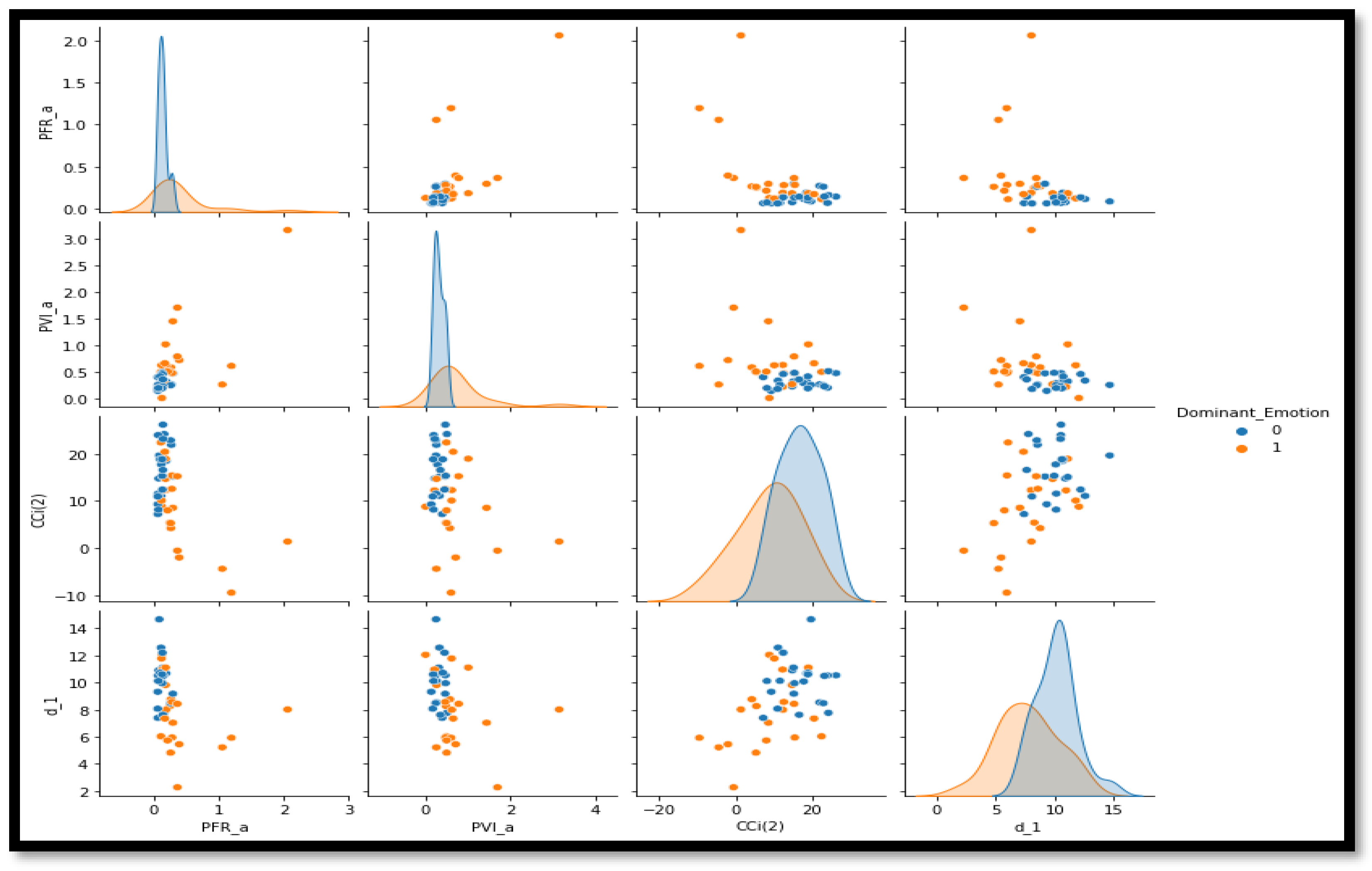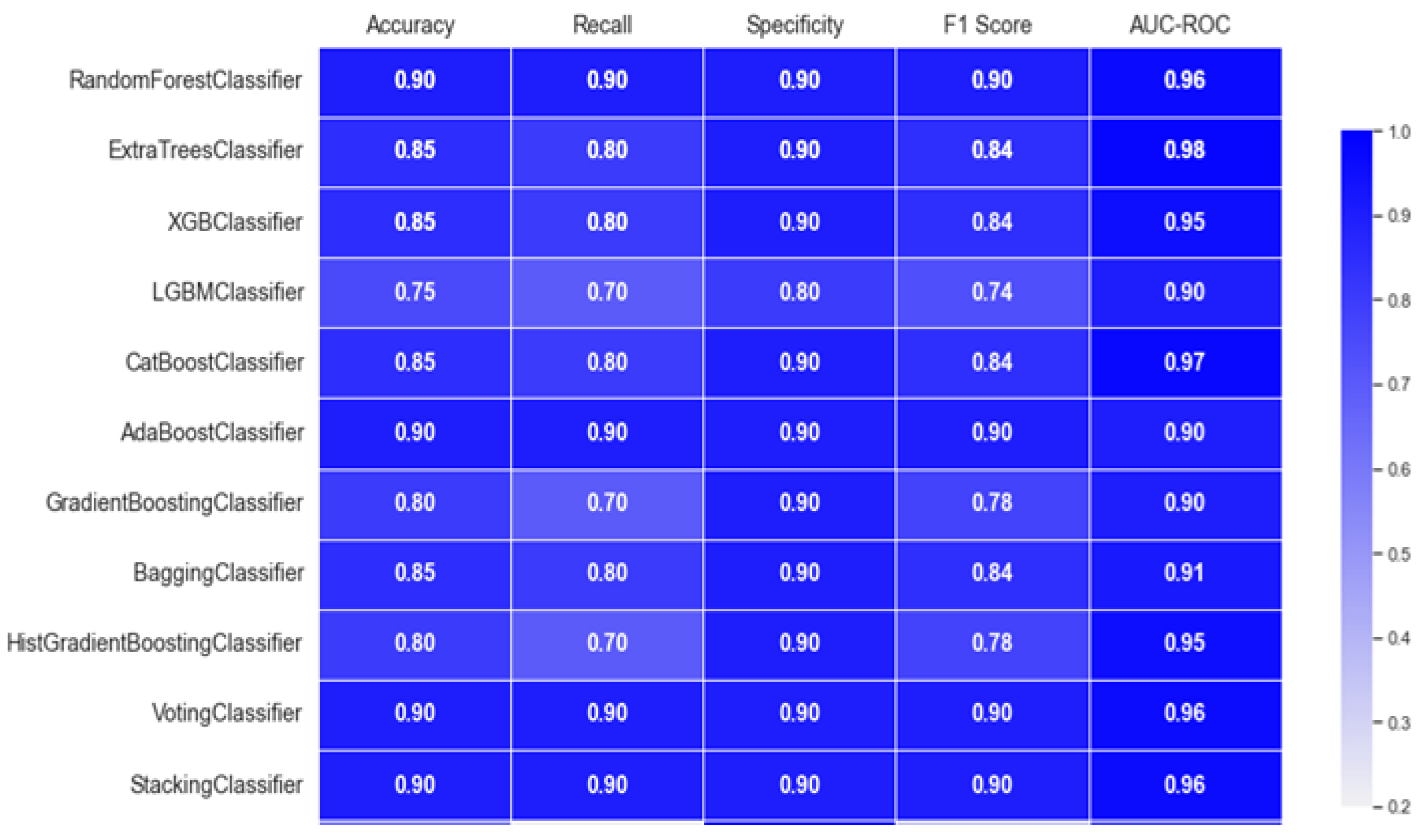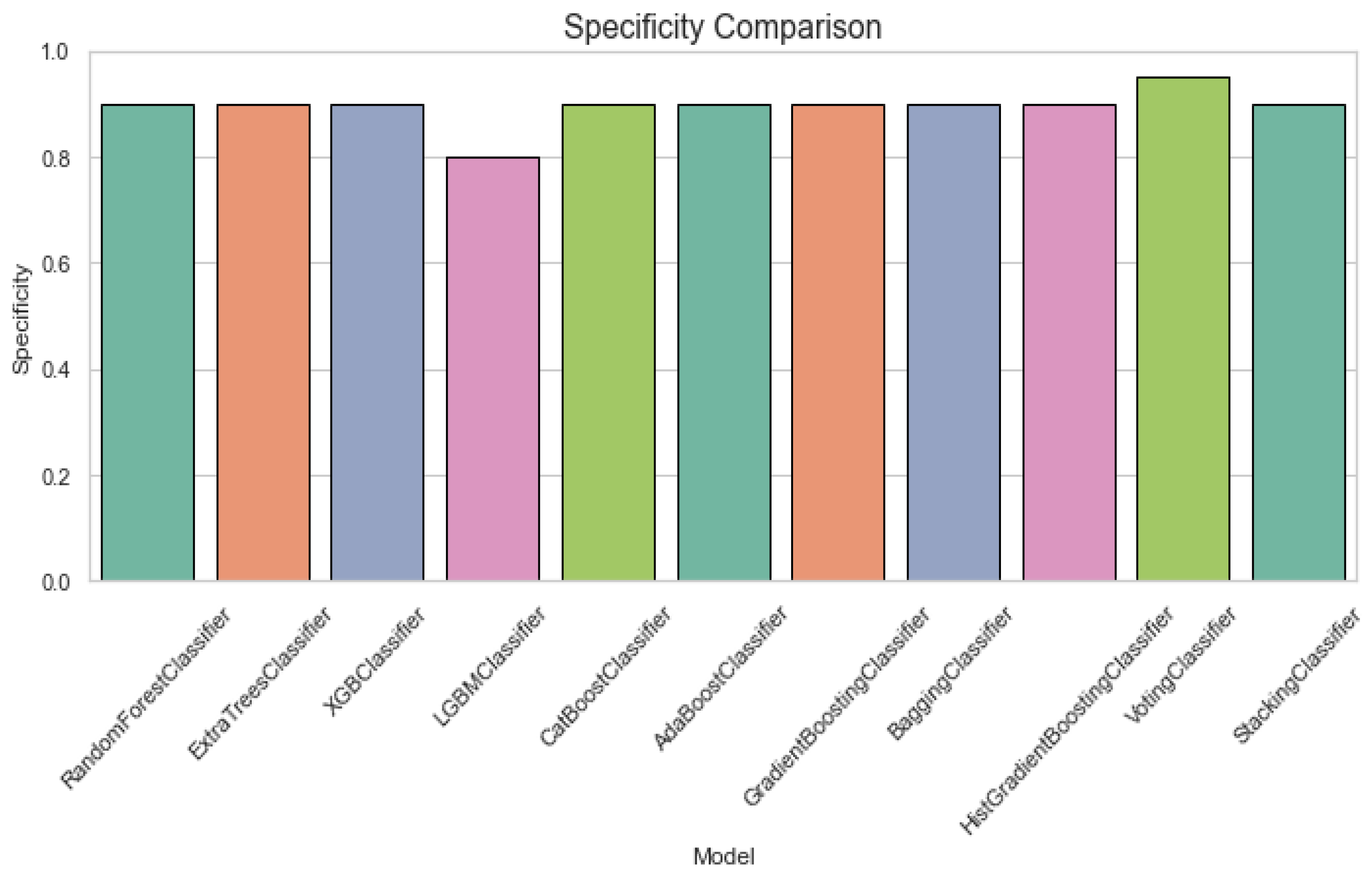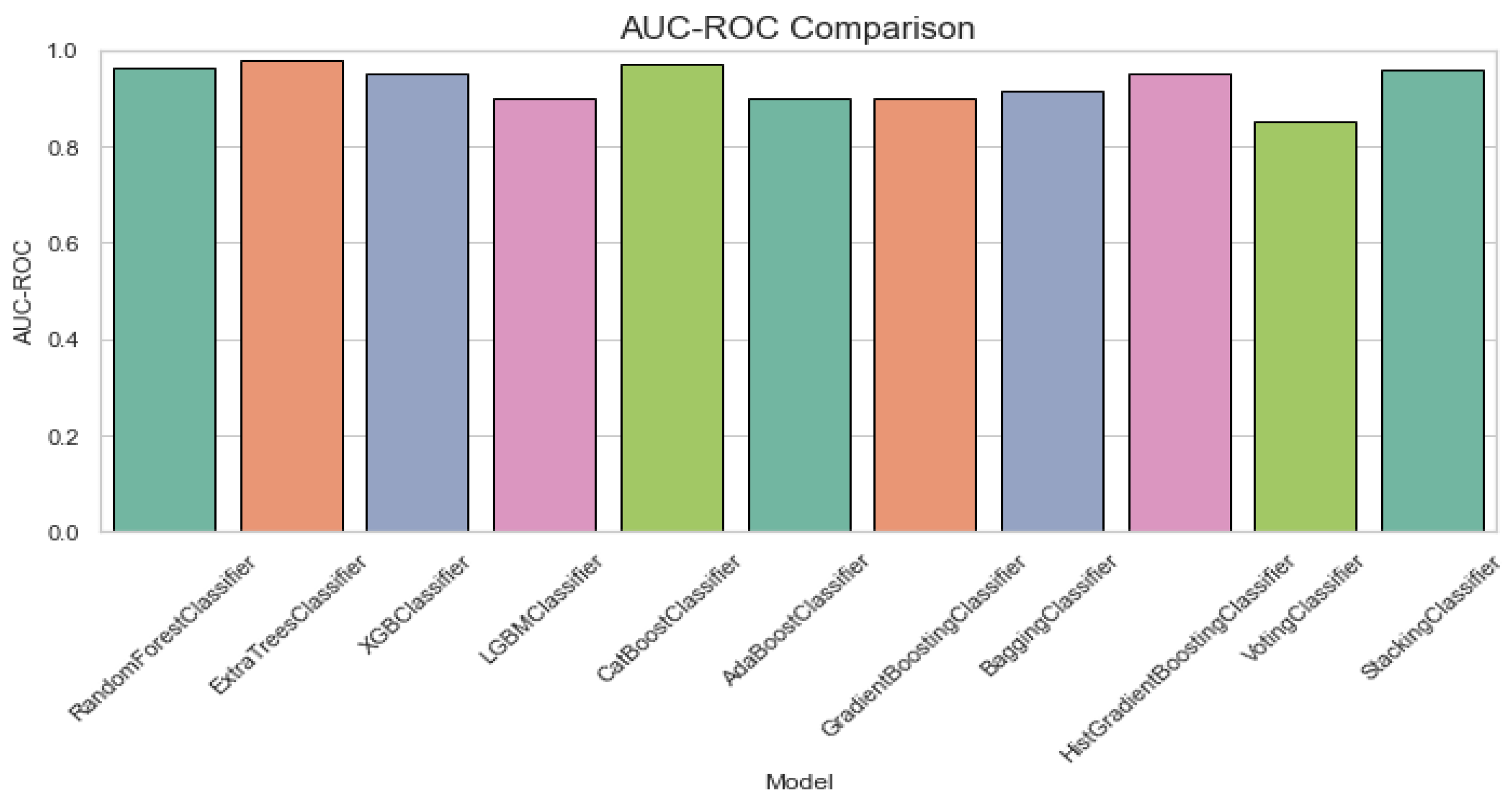Review on Classification of Amyotrophic Lateral Sclerosis Using Ensemble Classifiers †
Abstract
1. Introduction
2. Literature Review
3. Methodology
4. Experiments and Results
5. Conclusions
Author Contributions
Funding
Institutional Review Board Statement
Informed Consent Statement
Data Availability Statement
Conflicts of Interest
References
- Erdaş, Ç.B.; Sümer, E.; Kibaroğlu, S. Neurodegenerative disease detection and severity prediction using deep learning ap-proaches. Biomed. Signal Process. Control. 2021, 70, 103069. [Google Scholar] [CrossRef]
- Iadanza, E.; Fabbri, R.; Goretti, F.; Nardo, G.; Niccolai, E.; Bendotti, C.; Amedei, A. Machine learning for analysis of gene expression data in fast- and slow-progressing amyotrophic lateral sclerosis murine models. Biocybern. Biomed. Eng. 2022, 42, 273–284. [Google Scholar] [CrossRef]
- Leão, T.; Madeira, S.C.; Gromicho, M.; de Carvalho, M.; Carvalho, A.M. Learning dynamic Bayesian networks from time-dependent and time-independent data: Unraveling disease progression in Amyotrophic Lateral Sclerosis. J. Biomed. Informatics 2021, 117, 103730. [Google Scholar] [CrossRef] [PubMed]
- Migliorelli, L.; Massini, L.S.; Coccia, M.; Villani, L.; Frontoni, E.; Squartini, S. A deep learning-based telemonitoring application to automatically assess oral diadochokinesis in patients with bulbar amyotrophic lateral sclerosis. Comput. Methods Programs Biomed. 2023, 242, 107840. [Google Scholar] [CrossRef] [PubMed]
- Zhang, X.; Barkhaus, P.E.; Rymer, W.Z.; Zhou, P. Machine Learning for Supporting Diagnosis of Amyotrophic Lateral Sclerosis Using Surface Electromyogram. IEEE Trans. Neural Syst. Rehabil. Eng. 2014, 22, 96–103. [Google Scholar] [CrossRef] [PubMed]
- Behler, A.; Müller, H.-P.; Ludolph, A.C.; Kassubek, J. Diffusion Tensor Imaging in Amyotrophic Lateral Sclerosis: Machine Learning for Biomarker Development. Int. J. Mol. Sci. 2023, 24, 1911. [Google Scholar] [CrossRef] [PubMed]
- Ahangaran, M.; Chiò, A.; D’Ovidio, F.; Manera, U.; Vasta, R.; Canosa, A.; Moglia, C.; Calvo, A.; Minaei-Bidgoli, B.; Jahed-Motlagh, M.-R. Causal associations of genetic factors with clinical progression in amyotrophic lateral sclerosis. Comput. Methods Programs Biomed. 2022, 216, 106681. [Google Scholar] [CrossRef] [PubMed]
- van der Burgh, H.K.; Schmidt, R.; Westeneng, H.-J.; de Reus, M.A.; Berg, L.H.v.D.; Heuvel, M.P.v.D. Deep learning predictions of survival based on MRI in amyotrophic lateral sclerosis. NeuroImage Clin. 2017, 13, 361–369. [Google Scholar] [CrossRef] [PubMed]
- Bean, D.M.; Al-Chalabi, A.; Dobson, R.J.B.; Iacoangeli, A. A Knowledge-Based Machine Learning Approach to Gene Prioritisation in Amyotrophic Lateral Sclerosis. Genes 2020, 11, 668. [Google Scholar] [CrossRef] [PubMed]
- Yin, B.; Balvert, M.; van der Spek, R.A.A.; Dutilh, B.E.; Bohté, S.; Veldink, J.; Schönhuth, A. Using the structure of genome data in the design of deep neural networks for predicting amyotrophic lateral sclerosis from genotype. Bioinformatics 2019, 35, i538–i547. [Google Scholar] [CrossRef]
- Alqahtani, A.; Alsubai, S.; Sha, M.; Dutta, A.K.; Zhang, Y.-D. Intellectual Assessment of Amyotrophic Lateral Sclerosis Using Deep Resemble Forward Neural Network. Neural Netw. 2024, 178, 106478. [Google Scholar] [CrossRef]
- Çelik, M.H.; Gagneur, J.; Lim, R.G.; Wu, J.; Thompson, L.M.; Xie, X. Identifying dysregulated regions in amyotrophic lateral sclerosis through chromatin accessibility outliers. Hum. Genet. Genom. Adv. 2024, 5, 100318. [Google Scholar] [CrossRef] [PubMed]
- Gordon, J.; Lerner, B. Insights into Amyotrophic Lateral Sclerosis from a Machine Learning Perspective. J. Clin. Med. 2019, 8, 1578. [Google Scholar] [CrossRef] [PubMed]
- Kew, S.Y.N.; Mok, S.-Y.; Goh, C.-H. Machine Learning and Brain-Computer Interface Approaches in Prognosis and Individualized Care Strategies for Individuals with Amyotrophic Lateral Sclerosis: A Systematic Review. MethodsX 2024, 13, 102765. [Google Scholar] [CrossRef] [PubMed]
- Alzahrani, A.K.; Alsheikhy, A.A.; Shawly, T.; Azzahrani, A.S.; AbuEid, A.I. Amyotrophic lateral sclerosis prediction framework using a multi-level encoders-decoders-based ensemble architecture technology. J. King Saud Univ. Comput. Inf. Sci. 2024, 36, 101960. [Google Scholar] [CrossRef]
- Alemasov, N.A.; Timofeev, V.S.; Ivanisenko, N.V.; Kolchanov, N.A.; Ivanisenko, V.A. Computer analysis of the relation between hydrogen bond stability in SOD1 mutants and the survival time of amyotrophic lateral sclerosis patients. J. Mol. Graph. Model. 2022, 110, 108026. [Google Scholar] [CrossRef] [PubMed]
- Pancotti, C.; Birolo, G.; Rollo, C.; Sanavia, T.; Di Camillo, B.; Manera, U.; Chiò, A.; Fariselli, P. Deep learning methods to predict amyotrophic lateral sclerosis disease progression. Sci. Rep. 2022, 12, 13738. [Google Scholar] [CrossRef] [PubMed]
- Antoniadi, A.M.; Galvin, M.; Heverin, M.; Hardiman, O.; Mooney, C. Prediction of caregiver burden in amyotrophic lateral sclerosis: A machine learning approach using random forests applied to a cohort study. BMJ Open 2020, 10, e033109. [Google Scholar] [CrossRef] [PubMed]







| Article | Feature Extraction Method | Classification Models | Result | Observations |
|---|---|---|---|---|
| [11] | Neuroimaging, Clinical data | Deep Resemble Forward Neural Network | 95% accuracy in classifying cognitive function | Highly effective in combining neuroimaging and clinical data |
| [12] | Chromatin accessibility outliers | EpiOut Algorithm | Identifies genetic factors contributing to ALS through chromatin accessibility outliers | Significant in understanding genetic contributions to ALS |
| [13] | Variety of ALS-related data sources | Machine Learning | ML provides insights into ALS heterogeneity | ML models need further validation for heterogeneous ALS |
| [14] | Brain signals from BCIs | ML applied to Brain-Computer Interfaces (BCI) | ML applied to BCIs can decode complex brain signals for ALS patients | Synergy between ML and BCIs holds promise for ALS patient independence |
| [15] | Dual neural network approach (UNET and GAN) | UNET and GAN architectures | Early ALS detection with promising results (details unspecified) | Uses innovative dual architecture for early ALS detection |
| [16] | Caregiver data (Quality of life, psychological distress) | Random Forests | ML can predict caregiver burden and quality of life | ML tools provide actionable insights for caregivers |
| [17] | Hydrogen bond stability in SOD1 mutants | Accelerated Molecular Dynamics | Hydrogen bond stability correlated with patient survival times | Protein stability plays a role in ALS progression |
| [18] | Pooled ALS clinical trial data | Deep Learning | Accurate prediction of ALS progression using clinical data | Deep learning shows promise in predicting ALS progression |
| [1] | Gait analysis data | Convolutional LSTM, 3D CNN | Detects neurodegenerative diseases using gait analysis | Demonstrates potential for ML in multiple neurodegenerative diseases |
| [2] | Gene expression data | Pathway Analysis using ML | Identified immune response and inflammation as key biological processes in ALS progression | Offers valuable insights into ALS mechanisms and potential therapeutic targets |
| [3] | Time-dependent and independent patient data | Dynamic Bayesian Networks | Predicts ALS progression over time | Addresses ALS progression, aiding in prognosis |
| [7] | Causal graph analysis, ALSFRS-R score | Causal Graph Method, SVM Regression | Causal graph method showed greater precision in predicting ALS progression | Causal graph analysis improves precision in progression prediction |
| [4] | Audio recordings (Speech performance) | CNN (DDK-AID) | Remote monitoring and speech assessment tool for ALS progression | Enables early detection and monitoring of speech performance |
| [8] | MRI and clinical data | Deep Learning | 84.4% accuracy in predicting ALS survival | Combining clinical and MRI data improves survival prediction |
| [5] | Surface Electromyography (sEMG) data | Linear Discriminant Analysis | 90% sensitivity, 100% specificity in differentiating ALS patients using sEMG | Non-invasive sEMG method useful in ALS diagnosis |
| [10] | Genome data (genotype prediction) | Deep Learning (ALS-Net) | ALS-Net outperforms other methods in recall | ALS-Net offers strong recall and precision for genotype-based ALS prediction |
| [6] | Diffusion Tensor Imaging (DTI) | Machine Learning (for biomarkers) | DTI and ML show promise in detecting ALS biomarkers | Combining ML with neuroimaging can improve ALS understanding |
| [9] | Protein–protein interaction data, gene annotations | Knowledge-Based ML | ML identified new candidate genes for ALS | ML offers a pathway for discovering new ALS-related genes |
Disclaimer/Publisher’s Note: The statements, opinions and data contained in all publications are solely those of the individual author(s) and contributor(s) and not of MDPI and/or the editor(s). MDPI and/or the editor(s) disclaim responsibility for any injury to people or property resulting from any ideas, methods, instructions or products referred to in the content. |
© 2025 by the authors. Licensee MDPI, Basel, Switzerland. This article is an open access article distributed under the terms and conditions of the Creative Commons Attribution (CC BY) license (https://creativecommons.org/licenses/by/4.0/).
Share and Cite
Tiwari, S.; Shukla, A. Review on Classification of Amyotrophic Lateral Sclerosis Using Ensemble Classifiers. Eng. Proc. 2024, 82, 114. https://doi.org/10.3390/ecsa-11-22206
Tiwari S, Shukla A. Review on Classification of Amyotrophic Lateral Sclerosis Using Ensemble Classifiers. Engineering Proceedings. 2024; 82(1):114. https://doi.org/10.3390/ecsa-11-22206
Chicago/Turabian StyleTiwari, Shamik, and Amar Shukla. 2024. "Review on Classification of Amyotrophic Lateral Sclerosis Using Ensemble Classifiers" Engineering Proceedings 82, no. 1: 114. https://doi.org/10.3390/ecsa-11-22206
APA StyleTiwari, S., & Shukla, A. (2024). Review on Classification of Amyotrophic Lateral Sclerosis Using Ensemble Classifiers. Engineering Proceedings, 82(1), 114. https://doi.org/10.3390/ecsa-11-22206






